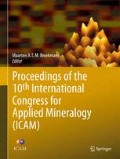Abstract
One of the tasks of technological mineralogy is to forecast opening of intergrowths of mineral grains while technogenic disintegration of mineral aggregate. The process of distraction of the aggregate proceeds to the extraction of the useful component from the aggregate it contains. Modern methods of destruction of rock material allows to manage this process for optimal crushing, before full opening of intergrowths, but not allowing to crush excessively the useful component and bearing its matrix of mineral grains. Before it was established that the strength of the bond on the boundaries of intergrowths of mineral individuals correlate with the history of the development of the aggregate and can be forecasted by the results of stereometrical ontogenetic analysis (Kotova, Proceedings of Australasian Institute of Mining and Metallurgy Aus IMM, Brisbane, Queensland, pp 681–686, 2008). During careful research of aggregate of different genesis the model was formulated (Brodskaya, L. Nauka LO, pp 23–28, 1987). The methodic of the forecast previous technogenic disintegration was developed on this model. This technique gives a quantitative measure of durability and completeness of disclosing of intergrowths while crushing, on the basis of a previous estimation of character of boundaries of intergrowths in the mineral aggregate. On the base of this research the boundaries of intergrowth in mineral aggregates can be performed as energetically balanced and not balanced. The first one, balanced, while destruction would open the first. Methodological work was held, mainly, at the ore aggregate of polymineral composition. For the first time methodic try out on monomineralic aggregates of the deposits of vein quartz and at deposits of quartzite in the South Urals. During the study of quartz from deposits of the South Urals the qualification of the boundaries of the mineral individual intergrowths was obtained. Four types of quartz grains were created by these criteria (Q1, Q2, Q3, Q4): by the character of boundaries of individuals (be crystallographic belonging and by its roughness), by the number and the character of distribution gas–liquid and mineral inclusions, by the number of blocks of wavy extinction within of one grain (traces of plastic deformations). By energetic balance three from four types of intergrowths boundaries were determined. By this method the most interesting for technologist quartz objects were determined.
Access this chapter
Tax calculation will be finalised at checkout
Purchases are for personal use only
References
Brodskaya, RL (1987): Geometrical and energy characteristic of mineral individuals in aggregate (stereological research). Technological mineralogy of the main industrial types of deposits. L. Nauka LO: 23–28.
Brodskaya, RL, and Kotova EL (2008): Stereometric analysis of ore aggregates for predicting energy savings during disintegration of ores. In: Proceedings of Australasian Institute of Mining and Metallurgy AusIMM, Brisbane, Queensland: 681–686.
Brodskaya, RL, and Marin, YB (1995): Energy characteristic of internal boundaries and processing properties of mineral aggregates. Reports of RAN (373/2): 232–234.
Kotova, EL (2009): Ontogenic analysis of vein quartz and estimation of quality of quartz products. RMS Annual Session: Ontogeny of Minerals Applied to Scientific and Industrial Uses. In: Conference Proceedings: 309–311.
Bykov, VN, and Igumenceva, MA (2004): Estimation of effectiveness of quartz mineral processing of deposit of the Southern Urals. In: Materials of the Annual Session on Experimental Mineralogy, Petrology, Geochemistry: 31–34.
Krylova, GI (2010): Estimation of mineragenic potential of quartzite, which are suitable for high-tech industry. Mineral Raw Material of the Urals (4/29): 3–31.
Author information
Authors and Affiliations
Corresponding author
Editor information
Editors and Affiliations
Rights and permissions
Copyright information
© 2012 Springer-Verlag Berlin Heidelberg
About this paper
Cite this paper
Brodskaya, R.L., Kotova, E.L. (2012). Petrographic Crystallography in Solving Problems of Applied Mineralogy. In: Broekmans, M. (eds) Proceedings of the 10th International Congress for Applied Mineralogy (ICAM). Springer, Berlin, Heidelberg. https://doi.org/10.1007/978-3-642-27682-8_11
Download citation
DOI: https://doi.org/10.1007/978-3-642-27682-8_11
Published:
Publisher Name: Springer, Berlin, Heidelberg
Print ISBN: 978-3-642-27681-1
Online ISBN: 978-3-642-27682-8
eBook Packages: Earth and Environmental ScienceEarth and Environmental Science (R0)

